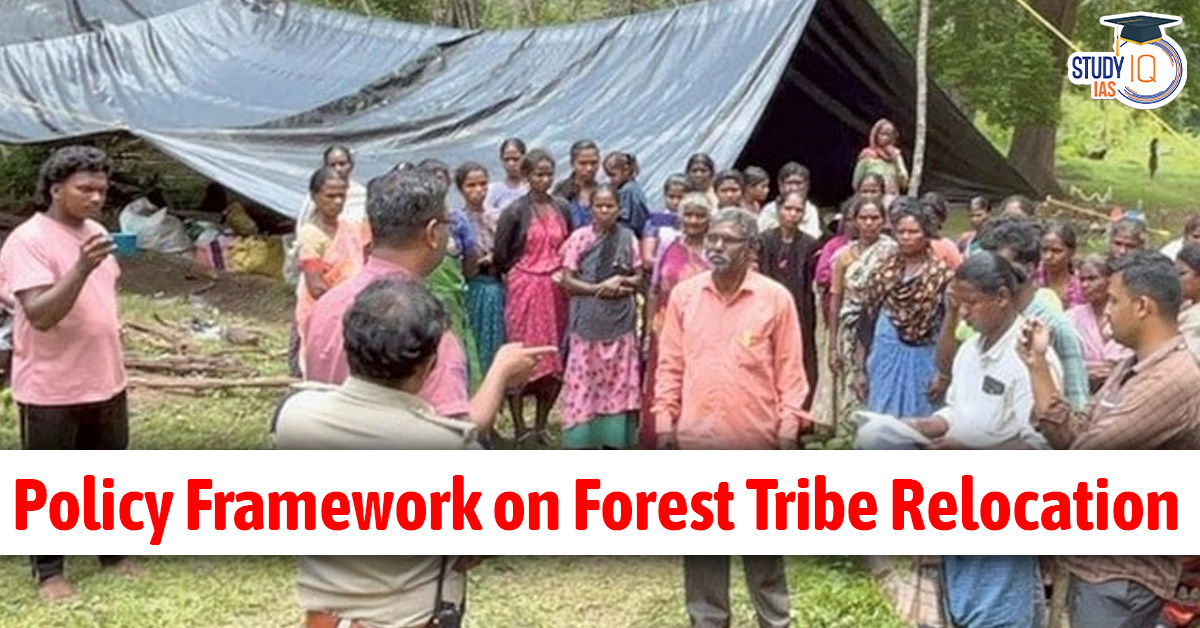Table of Contents
The Union Ministry of Tribal Affairs (MoTA) has released a new Policy Framework on Forest Tribe Relocation to ensure that the relocation of forest-dwelling communities from tiger reserves is voluntary, transparent, and rights-based.
Titled “Reconciling Conservation and Community Rights: A Policy Framework for Relocation and Co-existence in India’s Tiger Reserves,” this initiative marks a major reform in India’s forest governance and conservation policy.
The framework aims to harmonise wildlife conservation with the constitutional and legal rights of indigenous tribes, ensuring that relocation happens only when necessary and with informed consent.
Background: The Need for a New Relocation Policy
India’s tiger conservation journey, initiated through Project Tiger (1973), has saved the species from extinction but often created friction with local tribal populations.
Over the decades, thousands of forest-dwelling families have been relocated from core tiger habitats to make way for wildlife protection zones.
However, many of these relocations have been criticised for:
-
Ignoring the Forest Rights Act (FRA), 2006,
-
Inadequate compensation,
-
Lack of informed consent, and
-
Violation of tribal rights.
The new framework seeks to fix these gaps by ensuring that conservation and community welfare go hand in hand.
Key Objective of the Policy Framework
The Policy Framework on Forest Tribe Relocation (2025) aims to:
-
Protect tribal rights under the Forest Rights Act (FRA), 2006.
-
Ensure voluntary relocation based on free, prior, and informed consent.
-
Promote coexistence of communities and wildlife where possible.
-
Establish a joint governance system involving both the Tribal Affairs and Environment Ministries.
-
Create data transparency and accountability through national audits.
Main Features of the Policy Framework on Forest Tribe Relocation (2025)
1. National Framework for Community-Centred Conservation
The policy introduces a joint framework between the Ministry of Tribal Affairs and the Ministry of Environment, Forest, and Climate Change (MoEFCC).
This National Framework for Community-Centred Conservation and Relocation will:
-
Set clear timelines and procedures for relocation.
-
Mandate joint monitoring by both ministries.
-
Balance ecological objectives with human rights obligations.
2. Creation of a National Database (NDCCI)
A National Database on Conservation-Community Interface (NDCCI) will track all relocations, compensation payments, and post-relocation outcomes.
The NDCCI will:
-
Maintain data on each relocated family and village.
-
Record compensation, livelihood support, and land allocation.
-
Enable transparency and accountability at the national level.
3. Annual Independent Audits
The framework mandates annual audits by independent agencies to ensure compliance with:
-
Forest Rights Act (FRA), 2006
-
Wildlife Protection Act (WPA), 1972
-
Human rights standards
These audits will assess whether:
-
Relocation was voluntary and based on verifiable consent.
-
Compensation and rehabilitation were delivered as promised.
-
Post-relocation livelihoods are sustainable and dignified.
4. Verifiable Consent Mechanism
Before declaring any area as a tiger reserve core zone, the policy requires:
-
Gram Sabha approval, and
-
Written consent from individual households.
This ensures that no relocation occurs without the explicit agreement of the affected communities.
5. Right to Stay and Coexistence
Communities have the right to continue living inside forests under the Forest Rights Act unless relocation is ecologically unavoidable.
The framework promotes co-existence models, where forest-dwellers can participate in:
-
Wildlife monitoring,
-
Anti-poaching patrols, and
-
Sustainable resource management.
6. Relocation as the Last Resort
Relocation will only be permitted if:
-
Coexistence poses an ecological threat to species survival, and
-
All legal rights under the FRA have been recognised.
This ensures that relocation is a last resort, not the first step in conservation.
Why the Policy Was Introduced
1. Growing Tribal Concerns
Tribal communities and state governments have long raised concerns that Forest Rights Act provisions were being ignored in tiger reserves.
2. NTCA’s 2024 Directive
In June 2024, the National Tiger Conservation Authority (NTCA) instructed states to expedite village relocations from tiger reserves.
This order sparked protests from Gram Sabhas and tribal organisations, who claimed it violated the FRA.
3. Rising Protests and Legal Petitions
Tribal groups like the Jenu Kuruba community of Nagarhole National Park (Karnataka) appealed to the National Commission for Scheduled Tribes (NCST), demanding legal recognition of their rights before any relocation.
Existing Legal Framework
| Law / Authority | Purpose |
|---|---|
| Wildlife Protection Act (WPA), 1972 | Empowers creation of protected areas and relocation for wildlife protection. |
| Forest Rights Act (FRA), 2006 | Recognises rights of forest-dwelling communities and ensures voluntary relocation. |
| National Tiger Conservation Authority (NTCA) | Regulates tiger reserve management and relocation policies. |
Compensation and Current Status
Compensation Package
Each relocated family is entitled to a ₹15 lakh package — either as cash compensation or land and housing in relocation sites.
Current Relocation Statistics (as of August 2025)
-
5,166 families relocated from 56 villages across 7 states since January 2022.
-
64,801 families still reside within core tiger reserve zones.
This highlights the magnitude and sensitivity of the relocation issue in India.
Why This Policy Framework Is Important
1. Protects Tribal Rights
Ensures that tribal rights under the FRA are respected before any conservation decisions are made.
2. Strengthens Conservation Legitimacy
By making conservation people-centric, it reduces resistance and builds trust between forest departments and communities.
3. Enhances Transparency
The NDCCI and annual audits will track every relocation step, preventing misuse of funds and ensuring legal compliance.
4. Promotes Legal Coordination
For the first time, the Tribal Affairs and Environment Ministries will work together, bridging the historical policy gap between human rights and wildlife protection.
5. Encourages Community Participation
The framework promotes involving local and indigenous groups in forest management, eco-tourism, and conservation decision-making.
Challenges Ahead
Despite its progressive outlook, the policy faces challenges such as:
-
Coordination gaps between state forest and tribal departments.
-
Lack of awareness among forest dwellers about their rights.
-
Pressure from conservation lobbies for rapid relocation.
-
Ensuring livelihood security and social integration post-relocation.
Effective implementation will require strong monitoring, community participation, and political will.
Significance for India’s Conservation Future
India’s new Policy Framework on Forest Tribe Relocation signals a paradigm shift — from exclusionary conservation to inclusive, rights-based environmental governance.
It ensures that tigers and tribes can coexist, and that conservation no longer means displacement but partnership.
By institutionalizing consent, accountability, and collaboration, the framework aligns India’s policies with UN Sustainable Development Goals (SDGs), particularly:
-
SDG 15: Life on Land
-
SDG 16: Peace, Justice, and Strong Institutions
-
SDG 10: Reduced Inequalities
Conclusion
The Policy Framework on Forest Tribe Relocation (2025) redefines how India approaches conservation — by placing people at the heart of environmental protection.
By ensuring voluntary relocation, recognition of rights, and community participation, the framework bridges the long-standing divide between tiger protection and tribal justice.
If implemented effectively, this policy could become a global model for inclusive conservation, demonstrating that protecting forests and empowering people can go hand in hand.


 India Needs Nutritional Transformation: ...
India Needs Nutritional Transformation: ...
 Tropical Forests Forever Facility (TFFF)...
Tropical Forests Forever Facility (TFFF)...
 State of Food and Agriculture Report (SO...
State of Food and Agriculture Report (SO...

























